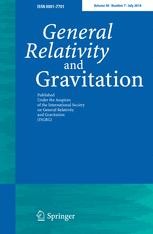GRG Editor's Choice: Non-perturbative 3D quantum gravity
 Goeller, C., Livine, E.R. & Riello, A. Non-perturbative 3D quantum gravity: quantum boundary states and exact partition function. Gen Relativ Gravit 52: 24 (2020). https://doi.org/10.1007/s10714-020-02673-3
Goeller, C., Livine, E.R. & Riello, A. Non-perturbative 3D quantum gravity: quantum boundary states and exact partition function. Gen Relativ Gravit 52: 24 (2020). https://doi.org/10.1007/s10714-020-02673-3
Editor's Choice (Research Article)
Published: 06 March 2020
"The results offer a first solid contact between results in AdS/CFT and loop quantum gravity, and thus provide an important bridge between different approaches to quantum gravity." (Handling Editor)
Abstract:
We push forward the investigation of holographic dualities in 3D quantum gravity formulated as a topological quantum field theory, studying the correspondence between boundary and bulk structures. Working with the Ponzano–Regge topological state-sum model defining an exact discretization of 3D quantum gravity, we analyse how the partition function for a solid twisted torus depends on the boundary quantum state. This configuration is relevant to the AdS3/CFT2 correspondence. We introduce boundary spin network states with coherent superposition of spins on a square lattice on the boundary surface. This allows for the first exact analytical calculation of Ponzano–Regge amplitudes with extended 2D boundary (beyond the single tetrahedron). We get a regularized finite truncation of the BMS character formula obtained from the one-loop perturbative quantization of 3D gravity. This hints towards the existence of an underlying symmetry and the integrability of the theory for finite boundary at the quantum level for coherent boundary spin network states.
The authors:
The authors have been collaborating on research in quantum gravity. Christophe Goeller is a PhD student working with Etera Livine, a CNRS senior researcher, in the Laboratoire de Physique at ENS Lyon, France. Aldo Riello is a PSI Fellow at Perimeter Institue, Waterloo, Canada.
GRG Editor's Choice:
In each volume of GRG, a few papers are marked as “Editor’s Choice”. The primary criteria is original, high quality research that is of wide interest within the community.
